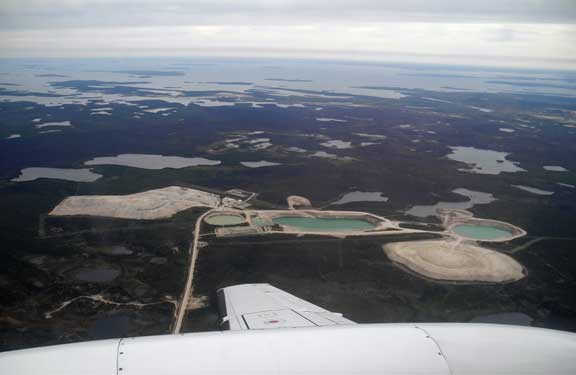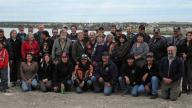At night, the lights at Rabbit Lake mine are visible in the west, looking across Wollaston Lake from Hatchet Lake Denesuline First Nation. “The mine opened up in the ’70s,” recalls Chief Bart Tsannie, “but it’s only recently that we’ve started to learn to live together. For a long time, there was nothing on the table for us.”
The Chief says they have received some benefits and some employment from the mine, but they are wondering how to deal with the impacts. How will they be able to sustain their culture and their livelihood, he wants to know, which relies on the lake and the caribou.
We’re in the heart of Canada’s uranium mining district over 600 kilometres north of Prince Albert, Saskatchewan. It’s a vast area, almost as flat as the prairies, but almost more lake than land.
The Hatchet Lake Indian Reserve is on the southeastern edge of Wollaston Lake, the world’s largest lake to drain naturally in two directions. It feeds the Fond du Lac River draining north into the Mackenzie River basin and the Arctic Ocean and the Cochrane River draining east into Hudson Bay.
The area’s oldest operating uranium mine, Rabbit Lake, borders its western edge. From the air, one can see two open pits along Collins Bay, as well as the mill and dumps for the mill wastes (tailings). The pits have been mined out, with waste rock piled to one side, the pits now filled with blue-green water that contrasts with the grey-blue of Wollaston and other lakes nearby. Owned and operated by Cameco, only the underground Eagle Point mine workings are active now. Other high-grade deposits, however, have been found nearby, and uranium mining is anticipated to last decades more. Its legacy will last much longer – millennia, in fact.
About thirty participants began this year’s Western Mining Action Network conference with a fly-in visit to Hatchet Lake, as guests of the First Nation and of Prince Albert Grand Council.
After welcoming us in the community hall, Chief Tsannie says that some 90% of their 1,313 members still maintain their language and they still follow the seasonal caribou hunting patterns. That same afternoon, and several more times throughout the course of the conference, we are treated to its dark meat served up several ways.
One of seven indigenous communities in the area, the Chief says Hatchet Lake is the only yet to reach an agreement with Cameco. “I’m not against the mine,” Chief Tsannie is clear, “I’m willing to work with them.” But he and the council have a lot of unanswered questions.
They want to protect their environment. They say the company makes it sound like there are no issues to be concerned about, but their elders have been seeing changes and when they send off dead fish or birds for testing, they says the results do not come back. And the lake, says Chief Tsannie, is their livelihood.
WMAN participants urge them to seek out independent sources of information.
Dr. Gordon Edwards, President of the Canadian Coalition for Nuclear Responsibility, indicates that government agencies are not the best place to start. He suggests that Hatchet Lake could participate in the WMAN network and take advantage of its diverse membership.
Edwards explains during a plenary discussion at the conference back in Prince Albert that Canada is one of a handful of countries that have a “full steam ahead” approach to grow the nuclear industry.
It is an approach that does not make sense in his perspective. Nuclear energy not only carries tremendous risks, he indicates, it is also too slow and too expensive to address the need to shift away from fossil fuel dependence. Renewable energy sources would be much quicker and cheaper.
Other countries are already headed in this direction. Germany, he says, has planned for a full shut down of its nuclear reactors by 2022. Following the Fukushima disaster, only 11 of 54 reactors remain active in Japan. In France, he adds, 67% of people are calling for a nuclear phase out.
The greatest costs associated with the industry are dealing with the waste. Edwards points out that nuclear legacy liabilities are estimated at $7 billion and nuclear waste management liabilities at $26 billion.
But given Canada’s stance, says Edwards, the role of the Canadian Nuclear Safety Commission (CNSC) is built around industry promotion. Meanwhile, the Commission has concluded that uranium mining is safe and so does not do health studies. “It’s an abrogation of their responsibility,” remarks Edwards, “but this state of affairs needs to be known in order to bring about pressure for change.”
During the visit to Hatchet Lake and later during the conference, others reflect that communities also need to take the lead if they want to defend what they value.
“Communities are often short-changed by mining, but communities also short-change themselves,” by not making stringent demands on governments and mining companies alike, comments one participant during a conference workshop about post-mine healing and clean-up.
Participants in this workshop heard two stories about indigenous communities in New Mexico and Northern Ontario, who decades after a mine has shut down are still struggling to ensure waste sites are adequately addressed, while past ways of life are difficult to recuperate.
“There’s not a lot of healing going on,” says Jamie Kneen of MiningWatch Canada with reference to Serpent Lake First Nation near Elliot Lake Ontario. “Rather, people are just trying to move on. The challenge is to survive mining, rather than to feel a victim of it.”
Environmental impact assessments often overlook the cultural and traditional values at stake from mining. Furthermore, workshop participants agree, the frequent emphasis on employment, as a key social indicator of community wellbeing, needs to be reevaluated. Jobs are only as good as long as they last, and the type of jobs available to local indigenous communities may be quite limited.
Furthermore, given that it can take decades, well beyond the life of a mine to move on from the impacts of what become “permanent waste management sites,” participants concluded that a more ideal starting point would be to ask, “what does it take to make a community sustainable?” and evaluate whether a mine will leave them better off or not in this framework. Defending their cultural and social practices in the event that a mine is built will require the community to ensure it happens.
Out in the hallway between workshops, a member of the Hatchet Lake First Nation remembers a moment she shared with her grandfather. He was standing on a hill overlooking the Rabbit Lake mine where his family trapline and cabins had been, and started crying. “The land will never be the same.”
For her, the most important thing that her people can do now to survive uranium mining in Northern Saskatchewan and to defend their culture and their livelihood, the lake and the caribou, is to keep passing on this struggle to future generations.

